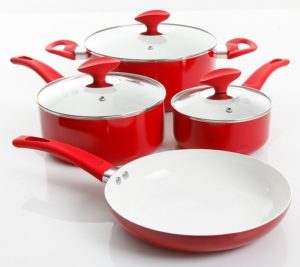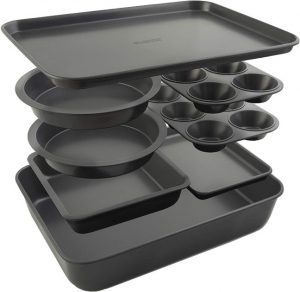Of pots and pans
Every time I enter an Ikea or a Home Centre, the ‘Alice in Wonderland’ feeling descends upon me. Then I enter the kitchen equipment area and it is Disneyland!
If you are like me and the shimmer of shiny pots and pans calls to you like the Pied Piper of Hamelin, let us undertake the ensuing journey together. For the heart shall tug but the head needs to rule! Even if you can’t hear the siren call of these beauties, do lend us your ear, for you might be our only hope – the ones who tug (maybe pull – a tad forcefully) us away from the temptations!
Now, there are many different kinds of pots and pans lining the shelves in these stores. We need to know which ones of these suit our needs best and which of them are good for us. One might wonder, how does it matter what we cook in – a pot is a pot is a pot. But no! A dish may be elevated or doomed by simply choosing the right cookware.
With so many options to choose from, choosing the right one can be confusing. So, let’s do a quick 101, starting with the major ones like:
1. Copper

Pros: Copper is a fantastic heat conductor. It heats and reacts to temperature changes quickly, giving the cook more control and making it easy to cook food evenly. It is also known to be very resistant to bacteria and is helpful in improving your gut health and strengthening the immune system.
Cons: On the flip side, copper reacts with alkaline or acidic foods, giving them a metallic taste. Light coloured foods can also develop grey streaks if they react with the copper compounds, which means you’ll be ingesting small amounts of copper. In larger quantities, copper can be toxic for the human body.
Solution: Buy copper pots lined with either tin or stainless steel. Tin and steel are both non-reactive metals and thus combine the thermal brilliance of copper with a versatility making the pot an all- rounder. Tin is easily combined with copper but less durable. One needs to get them re-tinned occasionally – known as ‘kalai chadana’ in India. Steel, though extremely durable, does not blend in with copper and has to be chemically bonded. Over time or under very high temperatures, it can un-bond and come apart.
Cleaning: Wash with regular soap and water but be gentle with it. Do not put it in the dishwasher. Over time, the copper outside of the pan will age, or get a patina. This is easy to polish away with a copper cookware cleaner, some homemade remedies, or just send it for a ‘kalai’
2. Aluminium

Pros: Aluminium has excellent thermal conductivity. It’s also lightweight and is an ideal metal for baking purposes. It has a larger-than-life use in the Indian kitchen and continues to play an important role in our lives.
Cons: If the cooking surface is aluminium, then there is a concern about the metal leaching into your food. Aluminium intake has been associated with an increased risk of Alzheimer’s (unsubstantiated). It has also been known to cause neurotoxicity, bone and renal diseases, as well as slowing down the brain cell functions. It especially reacts with acidic foods, imparting them a metallic flavour along with leaching in to them.
Solution: Aluminium cookware becomes a great addition to your kitchen if its surface is coated with either enamel, granite, or any other natural stone. It can also be sandwiched between layers of steel or made to undergo a chemical process that turns it into hard anodised cookware enabling it to retain the thermal conductivity yet gain a versatility that’s not possible otherwise.
Cleaning: Wash with regular soap and water. It can also be stacked in to the dishwasher.
3. Hard anodised

Pros: Hard anodised cookware is aluminium that has been hardened so that it becomes 30% harder than stainless steel. It has a non-stick, non-toxic, scratch-resistant, and non-reacting cooking surface. It retains the thermal conductivity of aluminium and can be largely used on most of the heat sources other than induction tops. The anodised surface is also conducive to the use of metal spoons and is relatively lightweight.
Cons: Most anodised cookware will not work on induction burners. However, some manufacturers are making these now. It may not be the best for sweet baked goods, as dark-coloured metals can cause over-browning if not watched closely.
Cleaning: This durable cookware can be easily cleaned in a dishwasher or with regular soap and water. Metal scrubbers, though, should be avoided, as they may scratch and damage the surface.
4. Cast iron

Pros: Cast iron cookware is extremely popular both with professional chefs and home cooks. Once hot, it stays hot, which means awesome slow-cooked food. It is extremely versatile, can be used to cook on any medium, from stovetop to a fire pit. Any type of spoon can be used on it, metal spoons will not scrape the surface. It is highly durable and comparatively inexpensive. It can actually become an heirloom! And is naturally non-stick if seasoned properly.
Cons: It doesn’t heat very evenly in a hurry. The best way to ensure an evenly heated pan is to pre-heat it for about 10 minutes, rotating it a bit every few minutes. It can also be pre-heated in a hot oven for 20 to 30 minutes. It can rust, chip, and crack easily if not properly cared for. But if seasoned correctly, the pan will have no issues and can last for generations. It is a metal and therefore is reactive. It doesn’t take well to acidic foods. Be careful not to drop it on your toes as it is quite heavy. Some effort is required to clean and maintain it.
Cleaning: Handwash it with soap and water, not too harshly if you want to maintain the seasoning. Dry it completely before storing. Should ideally be seasoned before storage.
5. Enamelled

Pros: Enamelled cookware offers many benefits of classic cast iron or aluminium, but without the hassle of seasoning or metal reactivity. Plus, most models come in a wide array of colours. Its non-reactive coating allows for long, slow cooking of acidic and alkaline foods. It can cook well over high heat and has excellent heat conduction and retention.
Cons: Does not have a non-stick coating and, unlike regular cast iron, seasoning cannot develop one. It is very heavy which makes it a bit difficult to handle. The coating can chip off due to rough handling or a fall.
Cleaning: Regular soap and water with a gentle scrubbing does the trick. For tough spots, pre-soak the pot with some soap and water. Do not use abrasive cleaners. Most often, enamelled cast iron is dishwasher-safe. However, repeated dishwasher use can wear away the coating.
6. Carbon Steel


Pros: Carbon steel pans are a cross between cast iron and stainless-steel cookware. They react to temperature changes quickly and can withstand high heat. Lighter than cast iron, they are excellent heat conductors and also durable. While carbon steel frying pans and woks behave more like cast iron and must be cared for similarly, carbon steel baking pans are typically coated with a non-stick or stick-resistant layer which makes them easier to maintain.
Cons: It is susceptible to rust and corrosion if not properly seasoned and maintained. Heat retention is lower than cast iron. It can be reactive with acidic and alkaline foods if chipped or not properly seasoned.
Cleaning: Carbon steel cannot be placed in the dishwasher; neither should it be left to sit in the sink with water or soap. Instead, wash gently with soap and water and any stuck-on spots with a non-abrasive scrub. Dry completely and re-season before storing.
7. Non-stick

Pros: Depending on pan material, it can be a great heat conductor. It is non-reactive and non-porous and allows cooking with less or no fat. It is easy to cook delicate foods such as fish or eggs on it as they won’t stick to the pan or break apart.
Cons: One must use plastic, silicone, or wooden spatulas as metal ones will scratch the non-stick coating. Non-stick coatings can break down at high heat so these pans have to be used at medium-high heat or below. The coating can have a short lifespan depending on how it’s cared for and how long it was exposed to heat. Teflon, the most common non-stick coating contains polytetrafluoroethylene (PTFE) and perfluorooctanoic acid (PFOA), which can give out toxic fumes if the coating is cracked. These chemicals have been found to increase the risk of tumours and cancer in humans.
Cleaning: Soap, water, and a soft sponge should clean up most messes. Avoid using any abrasive cleaners. Most non-stick pans are dishwasher-safe but repeated dishwashing can wear down the lining over time.
8. Glass

Pros: Glass is generally used as a baking dish and can be used in a microwave. It conducts heat very well which allows for great browning. It is non-reactive and so you can cook anything in it and store food right in the pan without worrying about developing flavours or colours that are somewhat ‘off’.
Cons: High temperatures may cause glass to shatter. May conduct heat too well for sweet items and may cause sugar to burn.
Cleaning: Glass is dishwasher-safe. You can also soak dirty pans and scrub away at tough spots. It must be saved from heat shock though; let glass dishes cool completely before immersing in cool water.
9. Clay pot


Pros: The clay pot is one of the most traditional cookwares known to man. Its porous nature allows both moisture and heat to circulate through the food which results in slow yet aromatic food. Clay is alkaline in nature and it interacts with the acidity in the food thereby neutralising the pH balance and eventually making food healthier and a lot tastier. It is believed to provide the required minerals including calcium, magnesium, iron, phosphorus, and sulphur that are beneficial to our health. Due to its heat resistance and slow cooking, the food retains all its oils and moisture and the nutrition of the food as well. Apart from the fact that clay cooking is healthier for us, it’s also healthier for the environment.
Cons: Cooking in clay pots is slow as clay resists heat. Cooking in clay pots might affect the taste of food because they have microscopic holes, in which previously cooked food particles might be stuck and this can affect the taste of the dish being cooked. With usage, clay or earthen pottery might show cracks over time. It is delicate and can break if it falls.
Cleaning: Clay pots should not be washed with soap as it may get lodged into the porous walls of the cookware. They should not be put into the dishwasher.
There are other types of cookware as well, but we must save something for next time too.
acknowledgements:
https://lifehacker.com/avoid-rookie-cooking-mistakes-use-the-right-pots-and-p-5934994
https://www.thekitchn.com/a-guide-to-the-best-material-for-pots-and-pans-pros-cons-168241
https://food52.com/blog/4728-a-guide-to-cooking-in-and-caring-for-copper?
https://foodal.com/kitchen/pots-pots-skillets-guides-reviews/copper-cast-iron-cookware-best/


